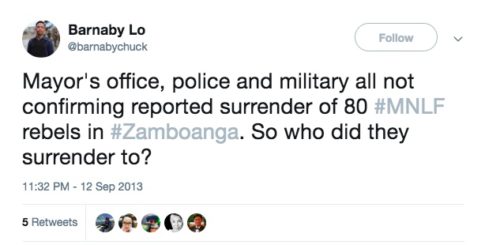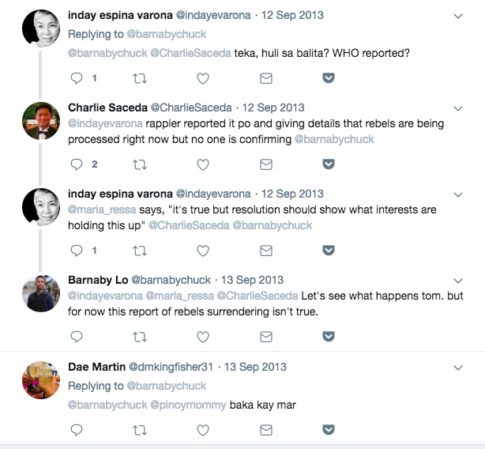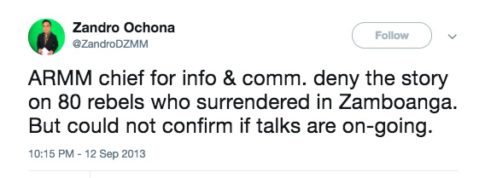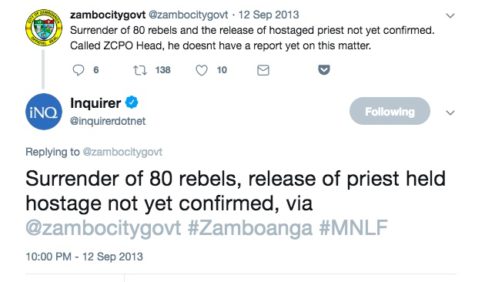I’ve generally stopped talking about Rappler. I stand with it in terms of the Duterte government’s blatant use of its power to silence and disallow its reporters from covering Malacañang, and certainly I will stand with the news site when it comes to the incompetent Mocha Uson proclaiming that the site is nothing more than social media, because I will side with a private entity over a government official wasting taxpayers’ money on idiocy.
But none of that means I’ve ceased to be critical of Rappler. And I will remain critical especially at a time when it has fashioned itself internationally as the bastion of independent journalism in the country, when it is seen by the international community as the only local media company that’s worthy of mention in the time of Duterte.
Replying to someone who thought exactly that on Twitter, I said Rappler has its own sins and sacred cows; another Twitter user asked for at least three instances to prove that opinion. In the interest of discourse: this is but one of a series of articles that will remind all of us of Rappler’s arrogance and failures, something that was used quite ably against it — for good or bad — by the Duterte social media campaign.
Let’s start with the Zamboanga Siege of 2013.
It was September 2013, and many of us were on Twitter, where many reporters and residents were updating us about what was going on in Zamboanga. At the risk of simplifying, MNLF fighters had taken over the Zamboanga City on September 9, taking hostages and using them as human shields as they clash with the military. Structures were burning, the MNLF fighters were using rocket propel grenades on the military. Thousands of residents were evacuated to churches and schools. In charge were DILG Secretary Mar Roxas, Defense Secretary Voltaire Gazmin, and Armed Forces Chief Gen. Emmanuel Bautista. (Primarily using the timeline of GMA News, which links to pertinent Tweets, FB posts, articles.)
Twitter was the social media app of choice: those in Zamboanga were talking about what it looked and sounded like from where they stood, reporters on the ground were sending updates. It was on the evening of September 12 though when Rappler “broke” the story that 80 MNLF fighters had surrendered. Soon after they tweeted and posted their story, reporters who were also on the ground in Zamboanga wondered where Rappler’s story came from. I had storified this moment, but alas, storify has closed down. Twitter archives though reveal enough:
The denials from the ground were swift, and the following day the President himself says there were no confirmed reports of a surrender.
On the evening of September 13, Rappler releases a statement standing by its story. They produce a timeline of events that “will show how events unfolded and were shaped by decisions made by officials involved in the siege in Zamboanga.”
On September 14, Rappler runs another story to prove that there was a surrender, and here is the councilor who was supposed to broker it: Teodyver Arquiza. Essentially, Arquiza’s narrative was about how, while the MNLF fighters were waiting for him, he was stuck at the command conference of the Crisis Management Committee. It takes the councilor’s word as truth — and we’re supposed to believe him, along with a purported member of the MNLF waiting to surrender, and someone from the PNP that Rappler purportedly talked to. And why not end the story with some drama?
When Rappler spoke to Arquiza on Friday, he said he is frustrated the arrangement did not work out. Assessing the events, he wondered if the outcome would have been different if he didn’t coordinate with government troops.
“Sayang talaga,” he said. (What a waste.)
Talontalon is one of the barangays cordoned off by the combined forces of the military and the police. But located at the rightmost end of the area, the situation there was not as bad as Sta Barbara or Sta Catalina.
But on Saturday, Arquiza said he fears the situation is changing.
“Ang gyera lumalapit na sa amin,” he said. (The war is coming closer.)
His voice was laced with fear this time.
There are no links to other sources, no other proof that this story was correct. We were supposed to take Rappler’s word for it, with its primary source being Arquiza (who, interestingly enough was back in the news three years after, for a graft case). This, even as all other media companies in Zamboanga covering the same siege, and all government offices, from the President to the DILG Secretary, the AFP to the PNP, to the LGU, denied that this surrender had happened, or was even supposed to.
Now one might ask what Rappler had to gain by putting out a story that no on else confirms, which essentially everybody else denied. Well, there’s this interesting, if tangential, assessment of Rappler’s handling of the Zamboanga Siege vis a vis its bias against Mar Roxas. There’s also this narration, which allows Rappler to be “critical” of the government’s handling of the crisis. But my answer is simpler: Rappler is fueled by social media hits, and likes, and shares, and impressions, and being the only one to carry a story, when all other media companies are writing about the same things, ensures them mileage.
A few months before the Zamboanga Siege, in June 2013, Rappler’s Marites Danguilan Vitug wrote about her shift from print to cyberspace, one of many important essays that should be read by anyone who puts Rappler on a pedestal of “better” and responsible journalism. Here, Vitug talks about the time she worked for ABSCBN online, “questioned the stories that simply quoted an official who was interviewed by DZMM or ANC,” asking “why were we uploading these? Wasn’t this what others, including myself, derided as “he-said, she-said” journalism?” She learned to “live with this type of stories” because the editorial team agreed “to provide background and context so that the single interview would make sense.” And here’s the clincher:
Sure, let’s break the news, be the first to do it, but we should update it to include enough substance.
So break the news, then make habol na lang? But what if the breaking news turns out to be false? Or what if it isn’t as large a story as you made it out to be when you first posted about it?
But I digress. Vitug ends with this:
Some say that the Internet encourages “churnalism”—because the news websites are under pressure to churn out news, like an assembly line of sausages. They miss out on the news gathering.
Online multimedia reporters tweet, interview news sources on camera, write breaking news, and update it with video. Often, there is no time to really gather the news, to talk to people and reflect on the story.
Newspaper reporters and editors have the luxury of time—compared to the Web—and do thoughtful journalism.
So if newspaper reporters and editors have the time to do thoughtful journalism, what does that say about what Vitug, Ressa, etal were doing at Rappler? ***




